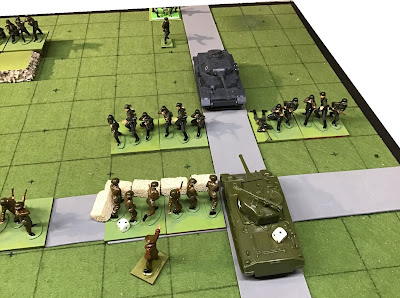Today's blog entry is nothing to do with wargaming. Instead, I am going to mention a local south-east London landmarks that was demolished yesterday as a result of an accident.
The tea hut on Blackheath has been there for over one hundred years, and was built to serve the needs of the growing number of motor car drivers and motorcycle riders using the old Roman road (Watling Street) that connects London to Dover. The section of road upon which it is located is now called Shooters Hill Road, and the hut was located at the junction with Goffers Road.
(Goffers is the eighteenth-century word from which the modern word golfers is derived. Golf was played on Blackheath from the time of the accession of James IV of Scotland to the English throne as James I. He set up his court at the Royal Palace of Greenwich, whose grounds (now Greenwich Park) abut the heath.)
Over the years, the Blackheath Tea Hut has become a local landmark, and until yesterday it continued to supply thirsty and hungry drivers (including a large number of police officers) with hot and cold drinks and food. It was not, however, popular with the Blackheath Society, which was set up in 1937, '
to preserve and improve Blackheath'. They have regarded the hut as an eyesore for years, and no doubt hope that it will not be rebuilt.
It would appear that at about 8.00pm last night a Mercedes car driving eastwards up Blackheath Hill left the road just after it becomes Shooters Hill Road ... and hit the tea hut. The impact was so great that the hut was turned through ninety degrees, and the member of staff inside was trapped and injured. She was rescued by a number of bikers who happened to have stopped at the hut for a drink, and was admitted to hospital with broken ribs and injury to her sternum. At present there is no information about the fate of the car's driver or whether or not they had any passengers in the car at the time of the accident.
Both images © @dougiedickson/Twitter
At least three ambulances and several fire appliances attended the scene as well as numerous police cars. Local roads were closed until late into the night, and bus services across Blackheath were diverted.
According to a statement made this morning by the hut's owner, the remains of the building had to be removed overnight as it was almost completely demolished. Emergency work had to be carried out at the site as the hut had both mains gas and electricity supplies which were severed, and were therefore dangerous.
For three years I drove past the hut almost every morning and evening going to and from my place of work in Brockley. I also had a car accident nearby when my old Mazda
Tribute 4x4 was driven into by a builder's truck whose driver had not realised that I had stopped because the traffic ahead of me had come to a halt. His claim that he had been blinded by the sun was laughable, as we were both travelling eastwards (in the same direction as the Mercedes car that hit the tea hut) at about 5.00pm ... when the sun was behind us! Needless to say, his insurance company agreed that he was liable, and my car was repaired at no cost to me or my insurers.
I do hope that the hut is rebuilt, and that the Blackheath Society do not manage to block its rebuilding. Over the years, too many of these old local landmarks have gone (usually in the name of 'progress'), and it would be a shame if this one was not reinstated.



























.jpg)
















.jpg)

.jpg)







